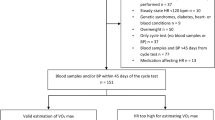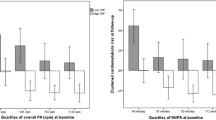Abstract
The aim of this study was to investigate levels of clustered cardiometabolic risk and the odds of being ‘at risk’ according to cardiorespiratory fitness status in children. Data from 88 10–11.9-year-old children (mean age 11.05 ± 0.51 years), who participated in either the REACH Year 6 or the Benefits of Fitness Circuits for Primary School Populations studies were combined. Waist circumference, systolic blood pressure, diastolic blood pressure, glucose, triglycerides, high-density lipoprotein cholesterol, adiponectin and C-reactive protein were assessed and used to estimate clustered cardiometabolic risk. Participants were classified as ‘fit’ or ‘unfit’ using recently published definitions (46.6 and 41.9 mL/kg/min for boys and girls, respectively), and continuous clustered risk scores between fitness groups were assessed. Participants were subsequently assigned to a ‘normal’ or ‘high’ clustered cardiometabolic risk group based on risk scores, and logistic regression analysis assessed the odds of belonging to the increased cardiometabolic risk group according to fitness. The unfit group exhibited significantly higher clustered cardiometabolic risk scores (p < 0.001) than the fit group. A clear association between fitness group and being at increased cardiometabolic risk (B = 2.509, p = 0.001) was also identified, and participants classed as being unfit were found to have odds of being classified as ‘at risk’ of 12.30 (95 % CI = 2.64–57.33).
Conclusion Assessing cardiorespiratory fitness is a valid method of identifying children most at risk of cardiometabolic pathologies. The ROC thresholds could be used to identify populations of children most at risk and may therefore be used to effectively target a cardiometabolic risk-reducing public health intervention.
Similar content being viewed by others
References
Adegboye AR, Anderssen SA, Froberg K, Sardinha LB, Heitmann BL, Steene-Johannessen J, Kolle E, Andersen LB (2011) Recommended aerobic fitness level for metabolic health in children and adolescents: a study of diagnostic accuracy. Br J Sport Med 45:722–728
Alberti KG, Zimmet P, Shaw J (2005) The metabolic syndrome—a new worldwide definition. Lancet 366:1059–1062
Andersen L, Sardinha L, Froberg K, Riddoch C, Page A, Andersen S (2008) Fitness, fatness and clustering of cardiovascular risk factors in children from Denmark, Estonia and Portugal: the European Youth Heart Study. Int J Pediatr Obes 3:58–66
Andersen LB, Hasselstrom H, Gronfeldt V, Hansen SE, Karsten F (2004) The relationship between physical fitness and clustered risk, and tracking of clustered risk from adolescence to young adulthood: eight years follow-up in the Danish Youth and Sport Study. Int J Behav Nutr Phys Act 1:6
Anderssen SA, Cooper AR, Riddoch C, Sardinha LB, Harro M, Brage S, Andersen LB (2007) Low cardiorespiratory fitness is a strong predictor for clustering of cardiovascular disease risk factors in children independent of country, age and sex. Eur J Cardiovasc Prev Rehabil: Off J Eur Soc Cardiol, Work Group Epidemiol Prev Cardiac Rehabil Exerc Physiol 14:526–531
Bailey DP, Boddy LM, Savory LA, Denton SJ, Kerr CJ (2012) Associations between cardiorespiratory fitness, physical activity and clustered cardiometabolic risk in children and adolescents: the HAPPY study. Eur J Pediatr 171:1317–1323
Baquet G, van Praagh E, Berthoin S (2003) Endurance training and aerobic fitness in young people. Sport Med 33:1127–1143
Blair SN, Kohl HW, Gordon NF, Paffenbarger RSJ (1992) How much physical activity is good for health? Annu Rev Public Health 13:99–126
Boddy LM, Fairclough SJ, Atkinson G, Stratton G (2012) Changes in cardiorespiratory fitness in 9- to 10.9-year-old children: SportsLinx 1998–2010. Med Sci Sport Exerc 44:481–486
Boddy LM, Thomas NE, Fairclough SJ, Tolfrey K, Brophy S, Rees A, Knox G, Baker JS, Stratton G (2012) ROC generated thresholds for field-assessed aerobic fitness related to body size and cardiometabolic risk in schoolchildren. PLoS One 7:e45755
Buchan DS, Ollis S, Young JD, Thomas NE, Cooper SM, Tong TK, Nie J, Malina RM, Baker JS (2011) The effects of time and intensity of exercise on novel and established markers of CVD in adolescent youth. Am J Hum Biol 23:517–526
Doshi KB, Kashyap SR, Brennan DM, Hoar BM, Cho L, Hoogwerf BJ (2009) All-cause mortality risk predictors in a preventive cardiology clinic cohort-examining diabetes and individual metabolic syndrome criteria: a PRECIS database study. Diabetes Obes Metabol 11:102–108
Eisenmann JC (2007) Aerobic fitness, fatness and the metabolic syndrome in children and adolescents. Acta Paediatr 96:1723–1729
Epstein L, Valoski A, Kalarchian M, McCurley J (1995) Do children lose and maintain weight easier than adults: a comparison of child and parent weight changes from six months to ten years. Obes Res 3:411–417
Giannessi D, Maltinti M, Del Ry S (2007) Adiponectin circulating levels: a new emerging biomarker of cardiovascular risk. Pharmacol Res: Off J Ital Pharmacol Soc 56:459–467
Gobbi R, Davies IG, Fairclough SJ, Mackintosh KA, Warburton GL, Stratton G, George KP, Hackett AF, Boddy LM (2012) Clustered cardiometabolic risk, cardiorespiratory fitness and physical activity in 10–11 year-old children. The CHANGE! project baseline. Arch Exerc Health Dis 3:207–213
Hopkins N, Stratton G, Maia J, Tinken TM, Graves LE, Cable NT, Green DJ (2010) Heritability of arterial function, fitness, and physical activity in youth: a study of monozygotic and dizygotic twins. J Pediatr 157:943–948
Katzmarzyk PT, Perusse L, Malina RM, Bergeron J, Despres JP, Bouchard C (2001) Stability of indicators of the metabolic syndrome from childhood and adolescence to young adulthood: the Quebec Family Study. J Clin Epidemiol 54:190–195
Leger LA, Mercier D, Gadoury C, Lambert J (1988) The multistage 20 metre shuttle run test for aerobic fitness. J Sports Sci 6:93–101
Lloyd-Jones D, Adams R, Carnethon M, De Simone G, Ferguson TB, Flegal K, Ford E et al (2009) Heart disease and stroke statistics—2009 update: a report from the American Heart Association Statistics Committee and Stroke Statistics Subcommittee. Circulation 119:480–486
Lobelo F, Pate RR, Dowda M, Liese AD, Daniels SR (2010) Cardiorespiratory fitness and clustered cardiovascular disease risk in US adolescents. J Adolesc Heal 47:352–359
Lohman T, Roche AF, Martorell R (1988) Anthropometric standardization reference manual. Human Kinetics, Champaign
Morrison JA, Friedman LA, Wang P, Glueck CJ (2008) Metabolic syndrome in childhood predicts adult metabolic syndrome and type 2 diabetes mellitus 25 to 30 years later. J Pediatr 152:201–206
Reppert A, Steiner BF, Chapman-Novakofski K (2008) Prevalence of metabolic syndrome and associated risk factors in Illinois. Am J Health Promot: AJHP 23:130–138
Ruiz J, Ortega F, Rizzo N, Villa I, Hurtig-Wennlof A, Oja L, Sjöström M (2007) High cardiovascular fitness is associated with low metabolic risk score in children: the European Youth Heart Study. Pediatr Res 61:350–355
Stary HC (1989) Evolution and progression of atherosclerotic lesions in coronary arteries of children and young adults. Arteriosclerosis 9:I19–I32
Stratton G, Canoy D, Boddy LM, Taylor SR, Hackett AF, Buchan IE (2007) Cardiorespiratory fitness and body mass index of 9–11-year-old English children: a serial cross-sectional study from 1998 to 2004. Int J Obes 31:1172–1178
Thomas NE, Baker JS, Graham MR, Cooper SM, Davies B (2008) C-reactive protein in schoolchildren and its relation to adiposity, physical activity, aerobic fitness and habitual diet. Br J Sport Med 42:357–360
Wang J, Ruotsalainen S, Moilanen L, Lepisto P, Laakso M, Kuusisto J (2007) The metabolic syndrome predicts cardiovascular mortality: a 13-year follow-up study in elderly non-diabetic Finns. Eur Hear J 28:857–864
Acknowledgments
We would like to thank all the schools, parents, participants and research teams involved in the REACH Y6 and the Fitness Circuits for Primary School Populations studies. We would also like to thank Nicola Lyons (phlebotomist), Dr. Marcus Auth, Paul Newland and Dr. Jeff Jones from Alder Hey Children’s NHS Foundation Trust. The REACH Y6 study was funded by Liverpool John Moores University. The Benefits of Fitness Circuits for Primary School Populations was funded by the University of the West of Scotland.
Conflict of interest
The research team confirm that there are no conflicts of interest for the current study.
Author information
Authors and Affiliations
Corresponding author
Rights and permissions
About this article
Cite this article
Houston, E.L., Baker, J.S., Buchan, D.S. et al. Cardiorespiratory fitness predicts clustered cardiometabolic risk in 10–11.9-year-olds. Eur J Pediatr 172, 913–918 (2013). https://doi.org/10.1007/s00431-013-1973-z
Received:
Revised:
Accepted:
Published:
Issue Date:
DOI: https://doi.org/10.1007/s00431-013-1973-z




